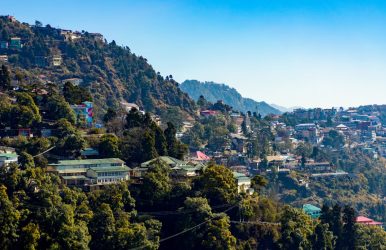Which Is The Best Time To Visit Mussoorie?
BY Shahnawaz Sep 23, 2022
Tourism in Uttarakhand is booming, with a focus on eco-tourism, adventure, and pilgrimage. In 2024, the state had around 6 crore visitors. Mussoorie, one of India's most popular hill stations, is a melting pot for all these tourism activities. Further, tourism in Mussoorie is expected to soar higher with the construction of the Dehardun to Mussoorie Ropeway. The ropeway will start from the Purkul village in Dehradun and end at the Library Chowk in Mussoorie. With the construction expected to be completed within 2026, the travel time between Dehradun and Mussoorie will be around 15 minutes. Further, when the ropeway is operational, it will be one of the many reasons for planning a trip to Mussoorie with family. However, with an elevation of 1,876 meters, Mussoorie also has snowfall and other extreme weather conditions. So, while planning a trip with your family, you must know the best time to visit Mussoorie. That’s why in this Tour and Travel blog, we will discuss the best season for a visit to Mussoorie, its weather conditions throughout the year, and the things to do. When Is The Best Time To Visit Mussoorie? The summer season, spanning between April and July, is the best time to visit Mussoorie. If you cannot make it to Mussoorie during these months, you can also plan a trip between September and mid-November. These months offer clear weather conditions. So, you enjoy better visibility of the Himalayan ranges and the valleys. However, if you want to see snowfall in Manali, late December to February is ideal for your Mussoorie visit. So, Mussoorie is beautiful throughout the year, and the best time to visit will depend on your desired experience. Here, I have given a brief overview of Mussoorie in all seasons. Summer (April to July) The most pleasing and the best time to visit Mussoorie is summer. Weather The temperature here remains around 11°C to 36°C. The day mostly remains cool and pleasing. But at night, Mussoorie gets colder during these months. If you want to take a long trek or climb the rock, then this is the best weather. It is perfect weather when the cool of the hill fights with the heat of the summer, creating pleasing weather to keep you at ease. Things To Do In Mussoorie In Summer Having a majestic view of the Kempty falls from the Gun Hills is the best thing you can do once in Mussoorie. You can also drive to the highest point of Mussoorie, La Tibba. Also, in the summer, Mussorries dresses itself up with its richest summer festival. Their folk dances and other cultural programs are great to take view of. Monsoon (July To September) No, this is not the best time to visit Mussoorie if you are looking for fun, hiking, and trekking. But, if you want to see Mussoorie shrouded in mist, then the monsoon is the best time for that. Weather The monsoon is cold and covers Mussoorie with a shroud of mist. You can see a foggy envelope covering the towns during the morning and the evening. The tourists are lesser in number, and calm and peace remain constant during this time. The temperature remains at 20°C and it can go up to 32 °C. Some roads remain closed, and all the greens remain washed and fresh during this time of the year. You can expect heavy rainfall almost every day. The color of the mountains will cleanse your soul. Things To Do In Mussoorie In Monsoon If you are visiting Mussoorie during the monsoon, then you must know that all the tourist spots are closed during this time. But, you can take part in local festivals like Olga and Hariayala. Winter (October to February) What is the best time to visit Mussoorie for snowfall? It is winter, without a doubt. You cannot expect it to snow in the summer. Also, if you want to see snowfall in Mussoorie, then you need to pack your bag from October to February. Weather The temperature goes down by 4°C. It can get really chilly. But you can also expect as high as 30°C during this time. The nights mostly get excessively cold – going down to sub-zero temperatures. The days during the winter are the best time to move around. But, as the evening approaches, it becomes colder. The nights are chilly. But, as the morning lightens up the mountain, it makes up for the perfect time to take a brisk walk around. Things To Do In Mussoorie In Winter Winter is the best time to visit Mussoorie if you want to see snowfall. The outworld appearance that Mussoorie takes during the winter is worth spending your money and time on. Everything is covered in snow and there are lots of winter activities you can do. The trekking trails remain open during this time. You Can also experience skiing in Mussoorie. You will see many tourists, but this time is crowded in Mussoorie. The most exciting part of staying in Mussoorie during the winter is Christmas. The celebrations here are wonderful and full of fun and happiness. Frequently Asked Questions (FAQs): I think you have found your answer about when to visit Mussoorie. However, here are some additional questions that I have answered. You can check them out if you are planning to visit Mussoorie. 1. How Many Days Is Enough For Mussoorie? Ans: You need to stay at least 2 to 3 days in Mussoorie if you are planning a trip. There are many great places to see. For instance, Lal Tibba, Kempty Falls, Company Garden, and Clouds End. You will need minimum of 2 days to visit all these places. 2. In Which Month Is There Snow In Mussoorie? Ans: You can expect snow in Mussoorie if you are visiting there from December to February. The weather remains snowy during this time of the year. 3. How Far Is Rishikesh From Mussoorie? Ans: You can go to Rishikesh from Mussoorie within a few hours of the journey. Rishikesh is only 74 km away from Mussoorie. Final words Anytime can be the best time to visit Mussoorie. But you must be aware of what you are expecting to see upon a visit there. The Queen of Hill Stations always welcomes you with her open arms. You can make it there at any time you want. But, if you want to see all the best tourist locations you need to choose the summer for a trip. So, plan your trip right and enjoy the best moments in Mussoorie. We wish you a happy journey! Read Also : Best Time To Visit Himachal Pradesh – Himachal Pradesh Guide Top 7 Best Places To Visit In Darjeeling – Travel Guide Which Is The Best Time To Visit Nainital?















